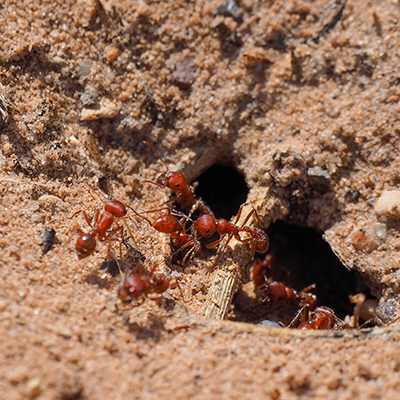If you’ve ever been stung by one of these little red fire engines then you know how fierce their sting can be. While entertaining guests, enjoying time outside with the kids, or just letting your dog get exercise, these invasive ants are not the kind of pests you want in your Atlanta area backyard. They can inflict pain and cause excessive damage to your lawn. So if you’re seeing large mounds of anthills protruding throughout your yard, chances are, you have a fire ant problem and it’s no laughing matter.
What Makes This Tiny Red Ant So Dangerous?
The sting from one fire ant can cause pain and in some, allergic reactions. Fire ant stings often result in white bumps at the site of the sting and believe me, these little buggers can sting multiple times. They also bite, mainly to get a grip on your skin but when they do, they release a toxic venom. You may not notice the bite at first because it is overpowered by the pain of the sting.
For most of us, a sting from a fire ant is an unpleasant experience causing some localized pain and itching for several days. A small percentage of people however develop allergic reactions which can include vomiting, stomach cramps, diarrhea, and nausea. And in worst cases, anaphylaxis, the life-threatening condition in which the throat closes up.
Fire ants will typically steer clear of humans unless provoked but they will attack pets and wildlife if their mounds are disturbed. For very small, young, or old pets with difficulty moving, a multitude of stings could be fatal.
Identify and Behavior of Fire Ants
I had my first encounter with fire ants over ten years ago while living on a military base in Texas. Being from the northeast, I was elated when the temperatures were in the 70s in January. Sitting out back, I quickly discovered that the anthill that I sat my folding chair beside was not your average ant hill. While I normally would not think twice about being invaded by ants, when one of these red little buggers bit me, I soon knew I was dealing with something specific to the southern climate.
Fire ants are actually invasive, originating from South America back in the 1930s. It is thought that they were brought over on fruit trucks and ships and once settled, they became comfortable with the warmer temperatures in Georgia and other areas in the south. They are similar in appearance to other native ant species and are approximately 1/16 to 1/4 of an inch in length. They can be red or black.
Two Kinds of Fire Ants In Georgia
Here in the Atlanta area, there are two kinds of fire ants, the single queen, and the multiple queen colonies.
Single Queen Colonies
Workers in single-queen colonies tend to forage within their territory, which they protect with their lives. They can contain 40 to 150 mounds inside one acre containing up to seven million ants and have only one queen.
Multiple Queen Colonies
On the other hand, workers from multiple-queen colonies are not territorial at all. Instead, they hop from one mound to another. A multiple queen colony can have over 200 mounds and 40 million ants.
Damage Fire Ants Cause to Your Atlanta Area Lawn
If your Atlanta area property is being invaded by a bunch of ant mounds pushed up throughout your lawn, you probably have a fire ant problem. Fire ant colonies cause turf damage and can seriously disturb your lawn’s ecosystem. Mounds vary in size but typically resemble the larger versions of small ant hills. Before the mound is visible, the active fire ant colonies have burrowed and tunneled through your yard and have taken up residence there. They will dwell in any soil type but prefer sunny, open fields such as parks, playgrounds, meadows, and golf courses.
Fire ant mounds can make any landscape look unappealing and a hazard to play upon. These bothersome creatures destroy your grass’s root structures, killing the grass and causing brown spots to appear. Having a lawn filled with fire ant mounds is like walking through a minefield, tiptoeing around active explosives waiting for them to go off. It’s a danger to you, your family, and your pets and makes mowing your lawn almost impossible.
Fire Ant Control
First, you want to be sure that you eradicate the queen. Once she is dead, the ants will either die or move on to other colonies. If left alive, she can replace the ants you kill just as fast.
Mount Treatments/Baits
Found at most lawn and garden or home good stores, mound treatments usually come in the form of dust or a granule you apply or throw on top of the visible mounds. The poison is usually coated on grains that the ants eat and deliver to the queen. The only downfall is that the dust/granules may lose their potency before the ants get around to eating them.
Insecticide
Chemical control of fire ants involves an insecticide injected into individual mounds or your entire landscape. These products are slow-acting but longer-lasting. And remember, any time you apply an insecticide yourself, you risk killing other beneficial insects or damaging the area surrounding the mounds.
You Need Effective Fire Ant Control From The Professionals at Papa Turf
Your best bet is to leave the fire ant control up to the professionals. Fire ants are dangerous and can inflict pain. Allow the experts who have been trained and use proper equipment to deal with them. Papa Turf offers effective pest control solutions that will exterminate these backyard bugs, no matter where they are hiding. Contact us now and learn how. Or give us a call at 770-389-0884.